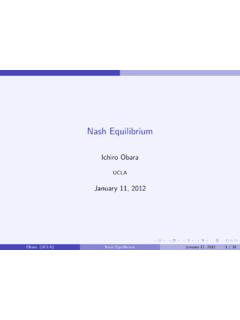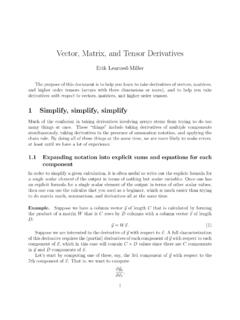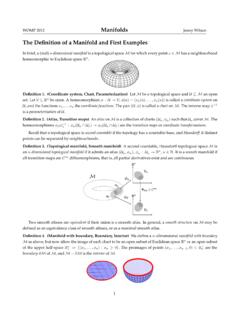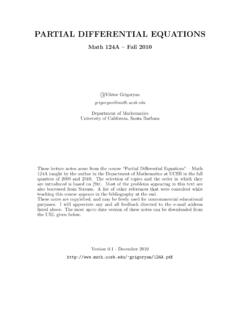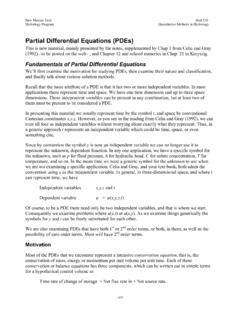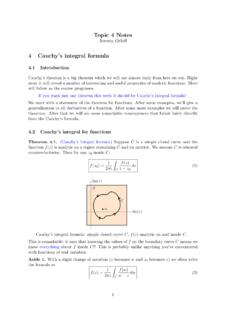Transcription of INCOME AND SUBSTITUTION EFFECTS - UCLA Economics
1 1 INCOME AND SUBSTITUTION EFFECTS [See Chapter 5 and 6]2 Two Demand Functions Marshalliandemand xi(p1,..,pn,m)describes how consumption varies with prices and INCOME . Obtained by maximizing utility subject to the budget constraint. Hicksiandemandhi(p1,..,pn,u)describes how consumption varies with prices and utility. Obtained by minimizing expenditure subject to the utility in INCOME An increase in INCOME shifts the budget constraint out in a parallel fashion Since p1/p2does not change, the optimal MRSwill stay constant as the worker moves to higher levels of in INCOME If both x1and x2increase as INCOME rises, x1and x2are normalgoodsQuantity of x1 Quantity of x2CU3BU2AU1As INCOME rises, the individual choosesto consume more x1and x26 Increase in INCOME If x1decreases as INCOME rises, x1is an inferiorgoodQuantity of x1 Quantity of x2CU3As INCOME rises, the individual choosesto consume less x1and more x2 Note that the indifferencecurves do not have to be oddly shaped.
2 The preferences are convexBU2AU17 Changes in INCOME The change in consumption caused by a change in INCOME from mto m can be computed using the Marshallian demands: If x1(p1,p2,m) is increasing in m, x1/ m 0,then good 1 is normal. If x1(p1,p2,m) is decreasing in m, x1/ m< 0,then good 1 is inferior. ),,()',,(2112111mppxmppxx 8 Engel Curves The Engel Curve plots demand for xiagainst INCOME , m. 9 OWNPRICEEFFECTS10 Changes in a Good s Price A change in the price of a good alters the slope of the budget constraint When the price changes, two EFFECTS come into play SUBSTITUTION effect INCOME effect We separate these EFFECTS using the in a Good s PriceQuantity of x1 Quantity of x2U1 ASuppose the consumer is maximizing utility at point p1falls, the consumer will maximize utility at point increase in x112 Demand Curves The Demand Curve plots demand for xiagainst pi, holding INCOME and other prices in a Good s Price The total change in x1caused by a change in its price from p1to p1'can be computed using Marshallian demand:),,(),,'(2112111mppxmppxx 14 Two EFFECTS Suppose SUBSTITUTION Effect The relative price of good 1 falls.
3 Fixing utility, buy more x1(and less x2). Effect Purchasing power also increases. Agent can achieve higher utility. Will buy more/less of x1if EffectU1 Quantity of x1 Quantity of x2 ALet s forget that with a fall in price we canmove to a higher indifference effectCThe SUBSTITUTION effect is the movementfrom point Ato point CThe individual substitutes good x1for good x2because it is now relatively cheaper16 SUBSTITUTION Effect The SUBSTITUTION effect caused by a change in price from p1to p1'can be computed using the Hicksiandemand function:),,(),,'(Effect 17 INCOME EffectU1U2 Quantity of x1 Quantity of x2 ANow let s keep the relative prices constant at the new level. We want to determine the change in consumption due to the shift to a higher curveCIncome effectBThe INCOME effect is the movementfrom point Cto point BIf x1is a normal good,the individual will buy more because real INCOME increased18 INCOME Effect The INCOME effect caused by a change in price from p1to p1' is the difference between the total change and the SUBSTITUTION effect:)],,(),,'([)],,(),,'([ Effect Income211211211211 UpphUpphmppxmppx 19 Increase in a Good 1 s PriceU2U1 Quantity of x1 Quantity of x2 BAAn increase in the price of good x1means thatthe budget constraint gets steeperCThe SUBSTITUTION effect is the movement from point Ato point CSubstitution effectIncome effectThe INCOME effect is the movement from point Cto point B20 Hicksian & Marshallian Demand Marshallian demand Fix prices (p1,p2) and INCOME m.
4 Induces utility u= v(p1,p2,m) When we vary p1we can trace out Marshallian demand for good 1 Hicksian demand (or compensated demand) Fix prices (p1,p2) and utility u By construction, h1(p1,p2,u)= x1(p1,p2,m) When we vary p1we can trace out Hicksian demand for good & Marshallian Demand For a normal good, the Hicksian demand curve is less responsive to price changes than is the uncompensated demand curve the uncompensated demand curve reflects both INCOME and SUBSTITUTION EFFECTS the compensated demand curve reflects only SUBSTITUTION effects22 Hicksian & Marshallian DemandQuantity of x1p1x1h1x1p1At p1the curves intersect becausethe individual s INCOME is just sufficient to attain the given utility level U23 Hicksian & Marshallian DemandQuantity of x1p1x1h1p1x' 1x1 p1 At prices above p1, INCOME compensation is positive because the individual needs some help to remain on U24 Hicksian & Marshallian DemandQuantity of x1p1x1h1p1x 1x 1p 1At prices below px, INCOME compensation is negative to prevent an increase in utility from a lower price25 Normal Goods Picture shows price rise.
5 SE and IE go in same direction26 Inferior Good Picture shows price rise. SE and IE go in opposite Good (GiffenGood) Picture shows price rise IE opposite to SE, and bigger than SE28 SLUTSKYEQUATION29 Slutsky Equation Suppose p1increase by p1. 1. SUBSTITUTION Effect. Holding utility constant, relative prices change. Increases demand for x1by 2. INCOME Effect Agent s INCOME falls by x*1 p1. Reduces demand by 111pph 1*1*1pmxx 30 Slutsky Equation Fix prices (p1,p2) and INCOME m. Let u= v(p1,p2,m). Then SE always negative since h1decreasing in p1. IE depends on whether x1normal/inferior.),,(),,(),,(),,(21*121 *1211121*11mppxmmppxupphpmppxp 31 Example: u(x1,x2)=x1x2 From UMP From EMP LHS of Slutsky: RHS of Slutsky:2121212/122/312/1*1*11141414121 mpmpmpppuxxhpm21221121*14),,( vand 2),,(ppmmpppmmppx 2/121211/212211)(2),,(e and ),,(ppuuppuppupph 2121*1121),,( mpmppxp32 CROSSPRICEEFFECTS33 Changes in a Good s Price The total change in x2caused by a change in the price from p1to p1'can be computed using the Marshalliandemand function:),,(),,'(21*221*22mppxmppxx 34 Substitutes and Complements Let s start with the two-good case Two goods are substitutesif one good may replace the other in use examples: tea & coffee, butter & margarine Two goods are complementsif they are used together examples.
6 Coffee & cream, fish & chips35 Gross Subs/Comps Goods 1 and 2 are gross substitutes if They are gross complements if0 and 01*22*1 pxpx0 and 01*22*1 pxpx36 Gross ComplementsQuantity of x1 Quantity of x2x 1x1x 2x2U1U0 When the price of x2falls, the SUBSTITUTION effect may be so small that the consumer purchases more x1and more x2In this case, we call x1and x2gross complements x1/ p2< 037 Gross SubstitutesQuantity of x1 Quantity of x2In this case, we call x1and x2gross substitutesx 1x1x 2x2U0 When the price of x2falls, the SUBSTITUTION effect may be so large that the consumer purchases less x1and more x2U1 x1/ p2> 038 Gross Substitutes: Asymmetry partial derivatives may have opposite signs: Let x1=foreign flights and x2=domestic flights. An increase in p1may increase x2(sub effect) An increase in p2may reduce x1(inc effect) QuasilinearExample: U(x,y) = lnx+ y From the UMP, demands are x1= p2 /p1 and x2= (m p2)/p2 We therefore have x1/ p2> 0 and x2/ p1= 039 Net Subs/Comps Goods 1 and 2 are net substitutes if They are net complements if partial derivatives cannot have opposite signs Follows from Shepard sLemma (see EMP notes) Two goods are always net substitutes.
7 Moving round indifference and 01221 phph0 and 01221 phph40 Gross Comps & Net SubsQuantity of x1 Quantity of x2x 1x1x 2x2U1U0In this example x1and x2are gross complements, but net substituteIf the price of x2increases and we want to find the minimum expenditure that achieves U1, we buy less of x2and hence more of and INCOME Effect Suppose SUBSTITUTION Effect The relative price of good 2 falls. Fixing utility, buy more x2(and less x1) Effect Purchasing power decreases. Agent can achieve lower utility. Will buy more/less of x2if in a Good 1 s PriceU2U1 Quantity of x1 Quantity of x2 BAAn increase in the price of good x1means thatthe budget constraint gets steeperCThe SUBSTITUTION effect is the movement from point Ato point CSubstitution effectIncome effectThe INCOME effect is the movement from point Cto point B43 Slutsky Equation Suppose p1increase by p1. 1. SUBSTITUTION Effect. Holding utility constant, relative prices change.
8 Increases demand for x2by 2. INCOME Effect Agent s INCOME falls by x*1 p1. Reduces demand by 112pph 1*2*1pmxx 44 Slutsky Equation Fix prices (p1,p2) and INCOME m. Let u= v(p1,p2,m). Then SE depends on net complements or substitutes IE depends on whether x1is normal/inferior.),,(),,(),,(),,(21*121*1 211121*21mppxmmppxupphpmppxp 45 Example: u(x1,x2)=x1x2 From UMP From EMP LHS of Slutsky: RHS of Slutsky:1211121112112/122/112/1*2*121414 14121 pmppmppmpppuxmxhp21221221*24),,( vand 2),,(ppmmpppmmppx 2/121211/221212)(2),,(e and ),,(ppuuppuppupph 0),,(21*21 mppxp46 DEMANDELASTICITIES47 Demand Elasticities So far we have used partial derivatives to determine how individuals respond to changes in INCOME and prices. The size of the derivative depends on how the variables are measured ( currency, unit size) Makes comparisons across goods, periods, and countries very difficult. Elasticities look at percentage changes.
9 Independent of Elasticities The INCOME elasticity equals the percentage change in x1caused by a 1% increase in INCOME . Normal good: e1,m> 0 Inferior good: e1,m< 0 Luxury good: e1,m> 1 Necessary good: e1,m< 1mxxmdmdxmmxxemxlnln//11111,1 49 Marshallian Demand Elasticities The own price elasticity of demand ex1,p1is If |ex1,p1| < -1, demand is elastic If |ex1,p1| > -1, demand is inelastic If ex1,p1> 0, demand is Giffen1111111111,lnln//11pxxppxppxxepx 50 Marshallian Demand Elasticities The cross-price elasticity of demand (ex2,p1) is1221121122,lnln//12pxxppxppxxepx 51 Elasticities: Interesting Facts If demand is elastic, a price rise leads to an increase in spending:0]1[][11,*11*11*1*111 pxexpxpxxpp52 Elasticities: Interesting Facts Demand is homoegenous of degree zero. Differentiating with respect to k, Letting k=1 and dividing by x*1, A 1% change in all prices and INCOME will not change demand for x1.),,(),,(21*121*1mppxkmkpkpx 0 *12*121*11 mxpxppxpm0m,,,12111 xpxpxeee53 Elasticities: Engel Aggregation Take the budget constraintm = p1x1+ p2x2 Differentiating, Divide and multiply by x1mand x2mwhere s1=p1x1/m is expenditure share.
10 Food is necessity ( INCOME elasticity<1) Hence INCOME elasticity for nonfood>1 mm 22111xpxp,mx,mxesesmxmxmxpmxmxmxp2121222 211111 54 Some Price ElasticitiesSpecific Price ElasticitiesNarrow Categories:Transatlantic Air in Price ElasticitiesBroad Surplus How do we determine how our utility changes when there is a change in prices. What affect would a carbon tax have on welfare? Cannot look at utilities directly (ordinal measure) Need monetary Surplus One way to evaluate the welfare cost of a price increase (from p1to p1 ) would be to compare the expenditures required to achieve a given level of utilities Uunder these two situationsInitial expenditure = e(p1,p2,U)Expenditure after price rise =e(p 1,p2,U)60 Consumer Surplus Clearly, if p1 > p1the expenditure has to increase to maintain the same level of utility: e(p1 ,p2,U) > e(p1,p2,U) The difference between the new and old expenditures is called the compensating variation(CV):CV= e(p1 ,p2,U) -e(p1,p2,U)where U = v(p1,p2,,m).









